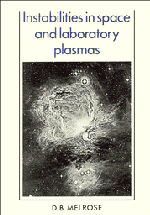Book contents
- Frontmatter
- Contents
- Preface
- Plasma formulary
- Part I Introduction to plasma theory
- Part II Instabilities in unmagnetized plasmas
- 3 Reactive instabilities
- 4 Kinetic instabilities
- 5 Particle motions in waves
- 6 Weak turbulence theory
- 7 Nonlinear instabilities and strong turbulence
- Part III Collision-dominated magnetized plasmas
- Part IV Instabilities in magnetized collisionless plasmas
- Appendix A The plasma dispersion function
- Appendix B Bessel functions
- Appendix C Collision frequencies
- Appendix D Transport coefficients
- Bibliographical notes
- References
- List of commonly used symbols
- Author index
- Subject index
4 - Kinetic instabilities
Published online by Cambridge University Press: 06 December 2010
- Frontmatter
- Contents
- Preface
- Plasma formulary
- Part I Introduction to plasma theory
- Part II Instabilities in unmagnetized plasmas
- 3 Reactive instabilities
- 4 Kinetic instabilities
- 5 Particle motions in waves
- 6 Weak turbulence theory
- 7 Nonlinear instabilities and strong turbulence
- Part III Collision-dominated magnetized plasmas
- Part IV Instabilities in magnetized collisionless plasmas
- Appendix A The plasma dispersion function
- Appendix B Bessel functions
- Appendix C Collision frequencies
- Appendix D Transport coefficients
- Bibliographical notes
- References
- List of commonly used symbols
- Author index
- Subject index
Summary
The bump-in-tail instability
Many microinstabilities have both reactive and kinetic forms. From a mathematical viewpoint one treats the reactive form by ignoring the imaginary part of the dielectric tensor and solving a real dispersion equation to find complex solutions, and one treats the kinetic form by assuming real frequencies to a first approximation and then including weak (negative) damping. To be more specific, in the weak-beam instability (§3.3) thermal motions are neglected and the correction to the real part of the dielectric tensor due to the presence of trie beam leads to a cubic equation (3.11) for the frequency shift of the Langmuif waves; this cubic equation has a real solution and a pair of complex conjugate solutions in the regime of interest. The kinetic version of this instability is known as the bump-in-tail instability. It is treated by first finding the imaginary contribution of the beam to the dielectric tensor and using this to evaluate the imaginary part of the frequency shift.
It is apparent from the foregoing discussion that the reactive and kinetic versions should be limiting cases of a single instability. This may be shown by finding both the real and imaginary parts of the frequency shift simultaneously. The real and imaginary parts of the frequency can be found as a complex solution for ω as a function of real k to the complex dispersion equation KL(ω, k) = 0, where both real and imaginary parts of KL are retained.
- Type
- Chapter
- Information
- Instabilities in Space and Laboratory Plasmas , pp. 45 - 62Publisher: Cambridge University PressPrint publication year: 1986
- 1
- Cited by

